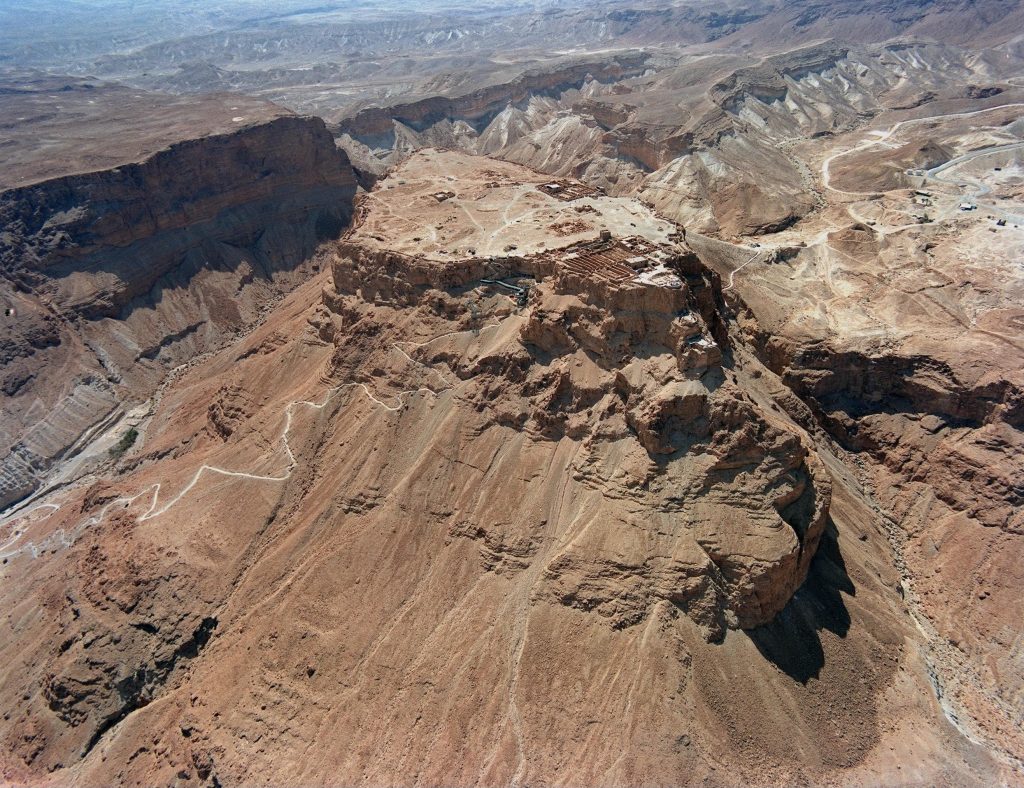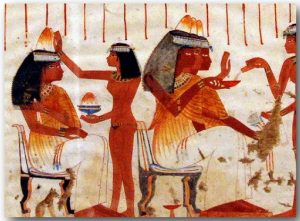Masada was an impressive fortress built upon a plateau to protect Jewish Zealots and refugees from the Romans. The Jews wisely chose this location because of its natural defenses against invaders. They imagined it would be impossible for anyone to besiege the city; the treacherous terrain and great outer wall surrounding Masada surely would protect it. Unfortunately, the Jews underestimated the Roman army.

Masada appeared to be the perfect fortress. Its four vertical sides made it nearly impossible to invade. The largest wall on the eastern side is one hundred forty meters above the desert floor, roughly half the size of the Eiffel Tower. From the east, there is a dangerous zig-zagging trail called the serpent’s path. The western side wall is eighty meters above the desert floor, as tall as the Statue of Liberty. The inhabitants took the extra precaution and built two walls on the perimeter of the plateau about 1400 meters long and six meters tall. The outer wall was 1.4 meters thick and the inner was 1 meter thick. Between the inner and outer wall, there was an empty space. During an invasion they planned to fill the gap with stone, wood, and dirt to strengthen the wall; until then it was used for storage. There were also twenty-meter-tall towers strategically spaced out throughout Masada for defensive reasons.1
The defenders were aware that if one were to attack, the first action the enemy would take would be to stop the water supply. Anticipating that possibility, the defenders built twelve cisterns to hold the water inside the fortress. Along the western slopes they had enough water stored to fill sixteen Olympic pools. It was very forward thinking of the Jews to do this. They also had many food storehouses toward the north. They kept grain, oils, corn, wine, dates, along with other foods. Thanks to the dry climate, storing the food was not a problem. In case they were to run low, the flat land would be ideal to grow additional food. Remains of the wall, tower, cisterns, food storage buildings, and other structures are still visible today.1

Unfortunately, these precautions were no match for the Roman army. In 73 C.E., Flavius Silva marched the Roman army and other troops totaling about 10,000 soldiers south to conquer Masada. Waiting on top of Masada were the 1,000 men (Jewish refugees and Zealots) willing to defend their safe haven. The Romans were aware it would take a significant amount of time to destroy Masada, so they set up camp and had Jewish war prisoners bring a constant supply of food and water. They first stopped up the aqueducts and diverted them for their own use. Next, they constructed a wall around Masada to prevent the inhabitants from escaping, and to cut them off from the outside world, a classic Roman war operation. The wall was three meters high and 3.2 kilometers long, and enforced by eight camps with many other guards posted. This impressive mechanism was built in a matter of days and can still be seen today.1

The Romans knew this would not be a quick victory; they would have to overthrow Masada by force. They came to the conclusion that the only way to reach the top of Masada was by making the steep side into a gradual incline. To do this, they took advantage of a natural spur called the white rock on the western side. It was nearly two hundred meters from the top of Masada to the edge of the natural gulf. The ramp to the top was built at a twenty degree incline. It took months to build the massive ramp. Every day, the inhabitants of Masada would wake up to see the enemy growing closer and closer, with no way for them to escape. As the Romans got close to the top, they became more vulnerable to the defenders. The Jews at the top could now shoot arrows and defend themselves against the Romans. As a result, the Romans had the Jewish war prisoners shield them so that they could shoot back. Within two months, the great ramp was complete. It was two hundred twenty meters long, and archaeologists assume it weighed as much as one and a half empire state buildings.4
The Romans attacked Masada with their siege towers. They rolled the massive towers up the man-made ramp to overthrow Masada. The inhabitants tried to fight back, shooting arrows at the towers and trying to destroy it with fire.4 The day before the final attack, the Romans carefully planned how they would conquer Masada. Early that morning, they charged up the ramp, and over the walls. To their surprise, they were not met with a fight. Instead, they encountered thousands of dead bodies. The few remaining women and children explained to them what had happened. The Jews knew they did not stand a chance against the Roman army of 10,000. They decided it would be better to die than to be conquered. Since Judaism does not allow suicide, they came to the conclusion they would have to kill each other. The men first killed the children and women; then they cast lots to decide who would be killed first, and who would have to be the last to commit suicide. It is ironic how they ignored the sixth commandment not to murder, but decided to alter its meaning to mean not to murder yourself. Despite the confusion, they ultimately chose death over slavery.6
- Encyclopedia Judea, 2007, s.v. “Masada,” by Michael Berenbaum. ↵
- Encyclopedia Judea, 2007, s.v. “Masada,” by Michael Berenbaum. ↵
- Encyclopedia Judea, 2007, s.v. “Masada,” by Michael Berenbaum. ↵
- The Greenhaven Encyclopedia of the Ancient World, 2002, s.v. “Siege of Masada,” by Don Nardo. ↵
- The Greenhaven Encyclopedia of the Ancient World, 2002, s.v. “Siege of Masada,” by Don Nardo. ↵
- Encyclopedia of Death & Human Experiences, 2009, s.v. “Mass Suicide,” by Clifton D. Bryant. ↵



86 comments
Hoa Vo
This is the first time I heard about the story of the Masada people and the Roman, and I was surprised by this tragic story. When I saw the title I was just thinking that there should be some reason that makes a mass suicide but I did not expect that people choose to kill their family, their people as the way to “suicide”. It is kind of a mess but also a sad story that shows how they defended themselves from being slaves but the way they did it was so wrong. Thank you for providing this well-written history article.
Carlos Hinojosa
That is probably the most messed up thing I’ve seen in history and it’s weirder that I’m barely hearing about it. However, what doesn’t make sense to me is that Romans weren’t actually that bad to the people they conquered unless they were a very serious enemy. To be honest, this just seems like a bunch of cowards that were too scared to die for what they believed in so they just took the easy way out. It may have been a hopeless situation but at least make some effort. Very good article.
Ariel Howell
I never heard about the Mass Suicide of Masada, ever in my life. when I saw the title for this article, I was shocked and a little bit concerned. When I read the article , I was really sad to find out that they were forced to become slaves. so they decided to kill themslefs.
Elliot Avigael
I have hiked Masada many times in the past, and believe me when I say that it is not for the faint of heart. It’s hard enough to do in modern times while wearing shorts and a tank top with a steady supply of food and water, so I can only imagine how difficult it was for the Romans to do in full suits of armor.
As a Jew, our Scripture tells us gift of life is the most sacred of all Divine gifts in Judaism, so it is hard to say if these men were martyrs performing their sacred duty of protecting the ancestral homeland, or if they committed suicide out of cowardice.
Madeline Emke
I never heard about this moment in my previous history courses, so when I saw the title for this article, I was shocked. The author describes the event with factual information and with very little emotional involvement, which was very helpful when reading the article because I did not feel completely overwhelmed with emotion. However, the article still carries a lot of emotion because the topic is very serious and overwhelmingly sad because of the large number of deaths that resulted because of religious intolerance.
Ava Rodriguez
This article is really interesting. I heard a little bit about this in class, but did not know the exact details of what happened. I could not imagine just waiting for hours completely surrounded by the Romans, and watching them grow closer. Rather than allowing themselves be forced to become slaves or be killed by their enemy, the Jews decided to kill each other before the Romans could.
Sharriah Martinez
Very interesting article. I have never heard of this. I didn’t know about the mass suicide, but I have studied much about the Romans and their conquering styles. Their conquering styles and battles were of course very very bloody. The information here did not seem out of the ordinary. It was very ironic that the people of Masada died in such a brutal way, the Romans would have done the same thing to them.
Michael Leary
Very interesting article, I had heard of this battle before, but, definitely learned a lot from this. Very sad how they felt that they had to kill themselves before really fighting the Romans, but, they must have been from the school of thought that it’s better to die on your feet than live forever on your knees, meaning its better to take a stand and die than to never take a stand.
Christopher Hohman
Nice article. The fifth commandment is though shall not kill not the sixth. It is very ingenious of the Romans to build a ramp that would help them reach the top of Masada. It is also interesting that they isolated the Zealots from the outside world and cut off their water supply. But the Zealots planned for this occurrence and were prepared already by the time the siege began. It must have been a bit of a spoiled party for the Romans when they reached the top of the hill, and discovered that the Zealots had already killed themselves.
Antonio Coffee
This is one of the many things in history that I have never heard of before. It almost sounds like something out of a book, building a giant ramp in order to attack a city at the higher elevation. It seems so hard to believe but seems believable because the Romans would let nothing stop them. It was horrible that they decided to kill themselves rather than be conquered. I would argue that they did not commit “murder” as murder requires a malicious intent in many understandings of the word.